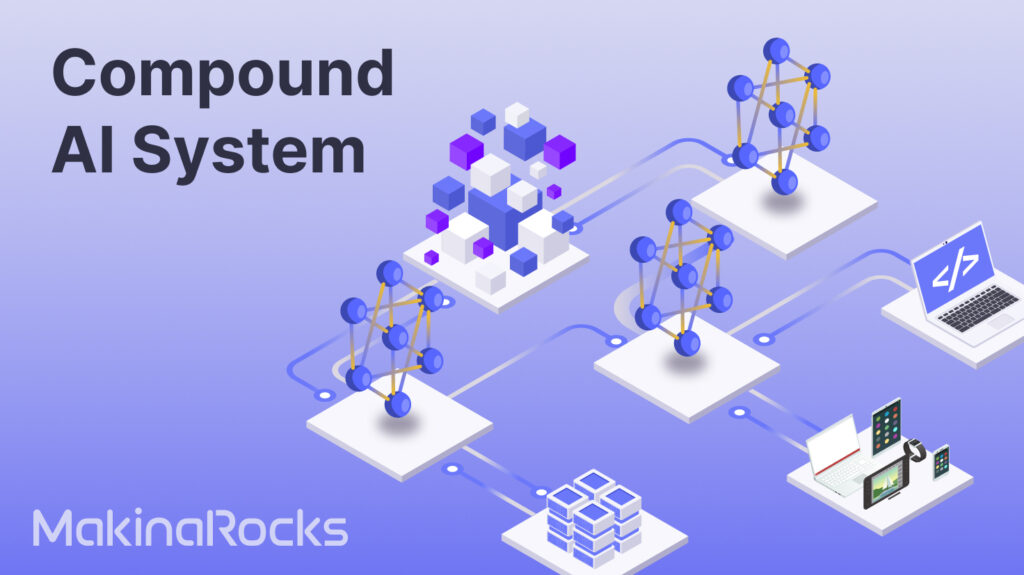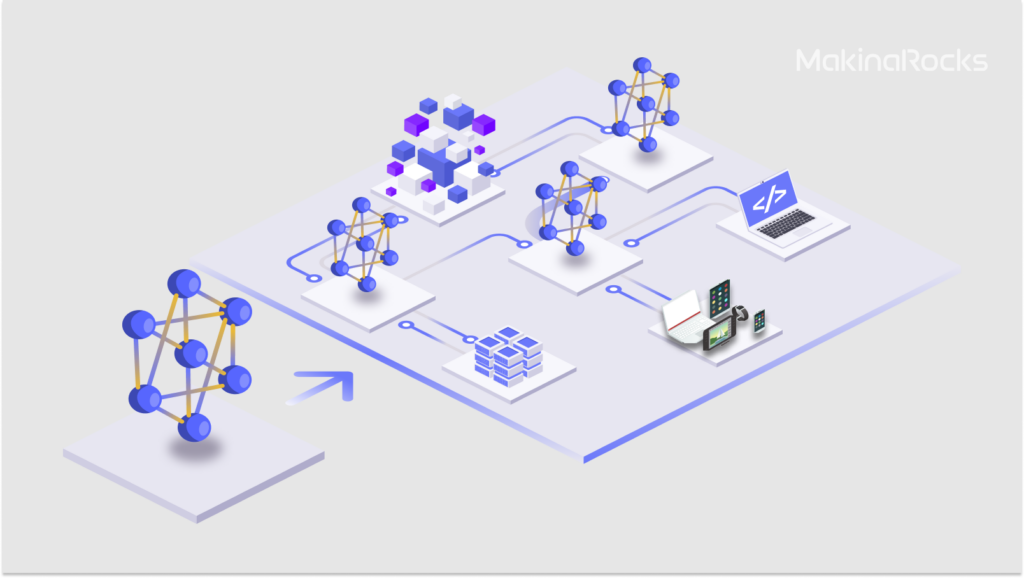
As AI adoption accelerates across industries, the demand for more advanced methods to address increasingly complex challenges grows. Enter compound AI systems—an innovative approach that integrates multiple components, such as AI models, retrievers, databases, and external tools, to tackle intricate tasks with precision. First introduced in the Berkeley Artificial Intelligence Research (BAIR) paper, “The Shift from Models to Compound AI Systems,” this methodology is revolutionizing how we approach AI in dynamic industrial environments, paving the way for a more adaptable and resilient future.
At MakinaRocks, compound AI systems are more than a concept—they form the foundation of our strategy to address the toughest real-world challenges. By integrating diverse data sources and systems, we go beyond conventional AI to deliver robust frameworks designed to optimize industrial operations. This blog will explore how MakinaRocks has embraced and advanced the compound AI approach, offering key insights from our journey in applying AI to industrial fields.
In the early days of AI’s integration into industry, many believed a single AI model could deliver transformative results. MakinaRocks initially followed this approach, developing standalone models for deployment. However, we quickly realized that even the most sophisticated single models couldn’t fully address the complexity and unpredictability of industrial environments.
Even if an AI model performs well under normal conditions, it can produce unexpected outcomes when it encounters new or unfamiliar input data. For instance, an AI model managing an air conditioning system may be expected to recommend temperatures within the 10 to 30 degrees Celsius range but could suddenly recommend 100 degrees due to unexpected new data—far beyond acceptable limits. This outcome highlights an inherent limitation of standalone neural network models: their difficulty in handling unfamiliar data effectively.
🔗 Why real-world AI is hard to achieve

Compound AI systems integrate multiple interacting components—such as AI models, retrievers, databases, and external tools—to handle intricate AI tasks with precision.
When you push boundaries, you create new starting points. At MakinaRocks, we recognized the importance of compound AI systems early on for this very reason. By shifting our perspective to embrace compound AI systems, we began to see problems in a new light. Unlike a single AI model, which offers limited control over its outputs, a compound AI system introduces multiple layers of control, such as post-processing and output filtering tailored to developers’ needs. These additional controls allow engineers to design and optimize systems that focus not only on AI model performance but also on solving real-world challenges effectively. Our commitment to compound AI systems stems from the complexity and scale of the industrial challenges we aim to address.
 MakinaRocks breaks new ground in this complex and unpredictable environment with industry-specific AI.
MakinaRocks breaks new ground in this complex and unpredictable environment with industry-specific AI.
Real-world AI represents a transformative technology that defines and resolves challenges in industrial environments using data. It empowers informed decision-making by analyzing countless variables and scenarios far beyond human capacity, delivering solutions at unparalleled speeds. This isn’t about replacing human abilities—it’s about achieving what humans cannot, pushing the boundaries of possibility.
🔗 Opening new horizons with real-world AI
Industrial sites are already equipped with advanced automation systems. In these highly optimized environments, AI takes on the more complex and difficult challenges. At MakinaRocks, we have embraced these challenges head-on. For example, we reduced six weeks of manual work to just three days by calculating a million variables, deriving optimal control logic, and cutting equipment failure rates from 0.5% to 0.1%. Additionally, we minimized energy consumption by 3% by reducing variability in energy control caused by operator differences. In another case, we identified the shortest path and fastest time to assemble thousands of components. Even in the retail sector, we optimized fresh produce pricing for supermarkets, increasing profits by 3%.
The true strength of AI lies in solving complex challenges. By simultaneously processing vast datasets and countless variables, it explores solutions that humans cannot achieve. Through simulating multiple scenarios, AI makes optimal decisions and automates intricate, repetitive tasks, enhancing both speed and precision. The more intricate the problem, the greater the transformative impact AI delivers.
Industries are turning to AI to address increasingly intricate challenges. This evolution demands compound AI systems—advanced frameworks designed to tackle complexity head-on. Why are these challenges becoming more complex? As AI technology advances and success stories proliferate, its capabilities continue to expand. This allows AI to address broader and more nuanced challenges. At the same time, growing recognition of AI’s potential is driving its adoption across processes, equipment, and systems. With more areas implementing AI, the challenges to be solved have become highly specific, requiring systems capable of handling diverse data and integrating multiple AI models, and leveraging compound AI systems to do so effectively.
As AI moves out of the lab and into industrial settings, the number of variables grow, and requirements become more refined. Early on, MakinaRocks focused on delivering individual AI models. However, as we deepened our understanding of industrial AI, the demand shifted. Companies now look for approaches that not only incorporate AI models but also integrate dashboards with systems, applications, and data visualizations for a comprehensive overview.
Industrial environments are inherently complex, with countless variables at play. Multiple processes run simultaneously, and a wide array of equipment and systems interact in intricate ways. This complexity makes it challenging to define problems clearly and even harder to develop effective approaches as issues become more granular and sophisticated. Compound AI systems address these challenges by enabling diverse data, multiple AI models, and interconnected systems to work together seamlessly. Acting as orchestrators, AI agents integrate these components to manage complex logic, make real-time optimal decisions, and automate actions effectively.
For MakinaRocks, compound AI systems are not just a vision—they are the standard we have been refining to address industrial challenges efficiently. These systems represent our commitment to realizing real-world AI and redefining what’s possible in industrial applications. Explore the 🔗 compound AI system use cases we’re developing to see how MakinaRocks is advancing the role of AI in dynamic and complex industrial environments.
Note: This post was translated from the original Korean version by Kyoungyeon Kim.